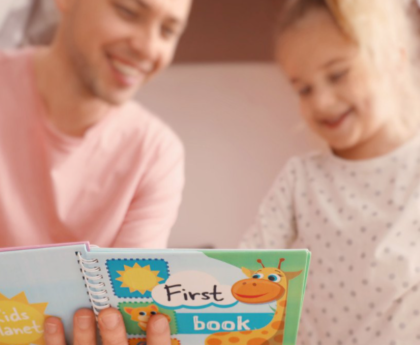Neurodevelopmental disorders such as attention-deficit/hyperactivity disorder (ADHD) can significantly affect academic performance. When it comes to reading, people with ADHD often have different ways of being able to effectively focus, comprehend, and retain information in text.
If your child has ADHD and is struggling with reading, know that this struggle doesn’t have to last forever. Keep reading to learn some practical tips on how you and your student’s teachers can foster strong reading skills for lifelong success.
How ADHD Impacts Reading Comprehension
The relationship between ADHD and reading can be dysfunctional for many, especially early on in school. About 30% of people with dyslexia also have ADHD. The primary symptoms of ADHD—inattention, hyperactivity, and impulsivity—can impact a person’s ability to read well.
To know which reading strategies might help your child most, let’s look at why and how ADHD makes reading difficult for them.
Inattention
Kids with predominantly inattentive ADHD struggle to focus and maintain attention. They get distracted easily by sounds, activities going on around them, interesting items, or even their own thoughts.
While everyone gets distracted at times, ADHD is a clinical diagnosis because its symptoms occur so frequently that they significantly impact the person’s life. One major example of this is an ADHD student’s difficulties with school.
Because of inattention, ADHD children will often read and re-read the same piece of text and yet still not be able to retain the information. This might leave them feeling frustrated, tired of trying, or perpetually stressed out over “falling behind.”
Working Memory
ADHD affects the brain’s executive function which regulates a person’s behavior, thoughts, memory, and emotions. It plays a role in time management, task completion, impulse control, and working memory. A child with ADHD might read and comprehend parts of a text initially but then forget the content soon after because of a limited ability to hold certain information in their working memory.
Hyperactivity/Impulsivity
Hyperactivity or impulsivity causes some children to seriously struggle with sitting still, which inhibits their capacity to read. Similarly, it’s possible for an ADHD student who doesn’t appear physically “hyper” to silently wrestle with a hyperactive mind or fidget constantly. Some children might have an impulsive need to talk, get up, squirm, interrupt people, and joke around when they’re expected to focus.
Processing Speed
ADHD can cause problems with “processing speed,” or the speed at which the brain assimilates and understands information. Children with attention deficits or co-occurring learning disorders like dyslexia might be slower at taking in certain types of information. They likely need more time to process complex thoughts, concepts, or experiences before moving on to the next one.
Self-Esteem
Students with various severities of ADHD might experience a low sense of self-esteem from constantly feeling “different” or incapable compared to their peers. This can impact their overall interest in school and learning. It can negatively affect their social confidence when reading is involved. They might strongly resist reading activities to avoid feeling embarrassed or “stupid” in front of teachers, parents, or classmates.
Ways to Help ADHD Students Read Better
There are many strategies parents and teachers can use to support ADHD readers. Here are a few places to start!
Limit Distractions
Ideally, find a setting where your child can read free from distractions. This could mean they need a quiet reading space at home or a calm, comfortable seat in the classroom.
Talk With Your Child’s Teachers
If your child is learning to read with ADHD, talk with their teachers. Together, you can come up with a plan to navigate your child’s reading difficulties. Additionally, many schools today offer accommodations for students with cognitive disabilities and learning disorders.
Seek Proper Treatment
ADHD is one of the most extensively researched and understood psychiatric conditions with many proven treatment methods available. With proper medical guidance and treatment, students with ADHD can thrive academically as skillful, successful readers. If your child isn’t currently being treated, it may be helpful to talk to medical professionals about appropriate care.
Read With Your Child
Reading with your child is one of the best things you can do for his or her literacy development. Reading aloud to (or with) your beginner reader models fluency, encourages engagement, and creates positive associations with reading. Aim to make a regular habit of reading with your child.
Let Children Read in Short Intervals
Don’t expect your child to focus on reading for long periods at a time. Instead, understand how their brain works and use it to their advantage.
Have them read in short intervals (15-25 minutes at a time) with plenty of breaks in between (5-10 minutes each). This prevents them from mental exhaustion and allows them to find relief in movement or a sense of reward between tasks. Additionally, it might help them process information in short spurts instead of getting overwhelmed by too much information all at once.
Start With Topics of Interest
Interest is a big factor of attention for ADHD. A lack of interest can cause the person to drift their attention elsewhere in search of something more stimulating. However, with ADHD, children typically sustain attention or even become intensely focused on topics and tasks they find enjoyable. Therefore, encourage beginner reading by providing materials related to your child’s hobbies and curiosities. Then, you can help them work their way up to reading about topics that aren’t as interesting.
Allow Active Reading and Alternative Seating
Active reading involves additional reinforcement such as:
- Reading aloud instead of silently reading
- Highlighting or underlining important parts of the text
- Writing notes while reading
- Repeating summaries after reading a section of text
- Using a notebook to jot down unrelated but important thoughts that come up (come back to these later instead of following them down the rabbit hole while reading)
For children who have difficulty sitting still and focusing, alternative seating options can be helpful while reading. For example:
- Pacing back and forth in a spacious area
- Reading somewhere outside
- Laying down on a lounge chair
- Sprawling out on a floor rug
- Using a standing desk
- Sitting on wiggle cushions or wobble stools
Find the Right Support
As with any disorder that impacts learning or executive function, there might be gaps in your child’s reading development. They could have missed some crucial skills required for reading proficiently, causing them to struggle further as these skills progress in the classroom. Getting a reading assessment so any setbacks can be addressed with supportive teachers and specialists might be a good idea.
Play Fun, Engaging Reading Activities With Your Child
ADHD children may benefit from reading activities that are fun, engaging, and scientifically proven to enhance literacy development. With instructional reading lessons and games in the Reading.com app, kids enjoy an involved activity that provides systematic, explicit reading instruction.
For more tips on how to support ADHD children as they learn to read, follow Reading.com and download the app for free!





